The Enterprise Sales Playbook
How to build and sell with champions to land larger deals.
Subscribe. Get new playbooks like this one by email.
Part 1: Making the Mental Shift
In a letter to Amazon shareholders, Jeff Bezos wrote:
We don’t do PowerPoint presentations at Amazon. Instead, we write narratively structured memos... The great memos are written and re-written, shared with colleagues who are asked to improve the work, set aside for a couple of days, and then edited again with a fresh mind. They simply can’t be done in a day or two.
This idea has shaped how I view the jobs of sellers and buyers more than any book, training, or mentor. What the Space Cowboy said here is profound.
Weird, I know. What do Amazon's internal communications have to do with B2B sales? At the risk of overstating it, everything.
You see, B2B sales is internal communication.
It's the process of finding and framing a problem. Then, aligning, on average, ten different people with conflicting opinions about the right way to solve that problem.
There are two, wildly important takeaways for sellers developing complex deals here.
The first is that sales reps are rarely in the room for moments that create and kill deals. Debates and decisions, between a company’s leadership about their problems and level of priority, generally happen during internal meetings — not sales meetings.
The second is that internal meetings, when effective, are the result of clear thinking outlined in a structured and compelling narrative. That’s why an Amazon memo can’t be created in a day.
This, at a fundamental level, should shift how you think about your job as a B2B seller.
Most believe a seller’s job is to pitch a solution to buyers, to close deals. But this view is dated.
Effective sales reps don’t sell to buyers. They sell with them. They influence their buyer’s thinking about the problem. They enable them to deliver a clear, compelling narrative that gets everyone aligned on what to do next.
What’s more, sales reps don’t close deals. Buyers do. Buyers have always been at the center of making a sale happen because a solution is far more than a product. A solution is the sum of all the problem discovery, consensus building, onboarding, and adoption of a product.
Which means a solution can’t exist without the buyer. Remove the buyer and you’re left with a product. But take a motivated buyer and you can, in fact, remove the seller and get a deal done.
The job of a seller, then, is to enable their buyer.
To help them move from where they are (a problem) to where they want to go (a payoff).
Your New Sales Job Description
You have a number. A target, a quota. To hit it, you need to shape the outcome of every deal in your pipeline. Which makes earning a seat at the proverbial decision table key.
If you’re sitting at the table, you can influence the decision. So then, how do you earn your seat? And if an internal meeting happens without you there, can you still shape the outcome?
Yes, in short. The way is by creating and enabling a champion — someone who’s fluent in the narrative you’ve developed throughout the sales cycle. Someone who knows the words their executives will resonate with.
We’ll go deeper on the profile of a champion. But for a minute, hear this.
Your job is to create and enable a committed champion for every deal in your pipeline.
You’re creating the real definition of an “inside sales rep” out of your buyer, and enabling their success. So what does a champion need? A strong internal narrative, plus the coaching and content to clearly message it.
What sales enablement teams do for their sales reps, is the same thing that top sales reps now do to enable their buyers. Think of this as sales reps becoming “an enablement team of one.”
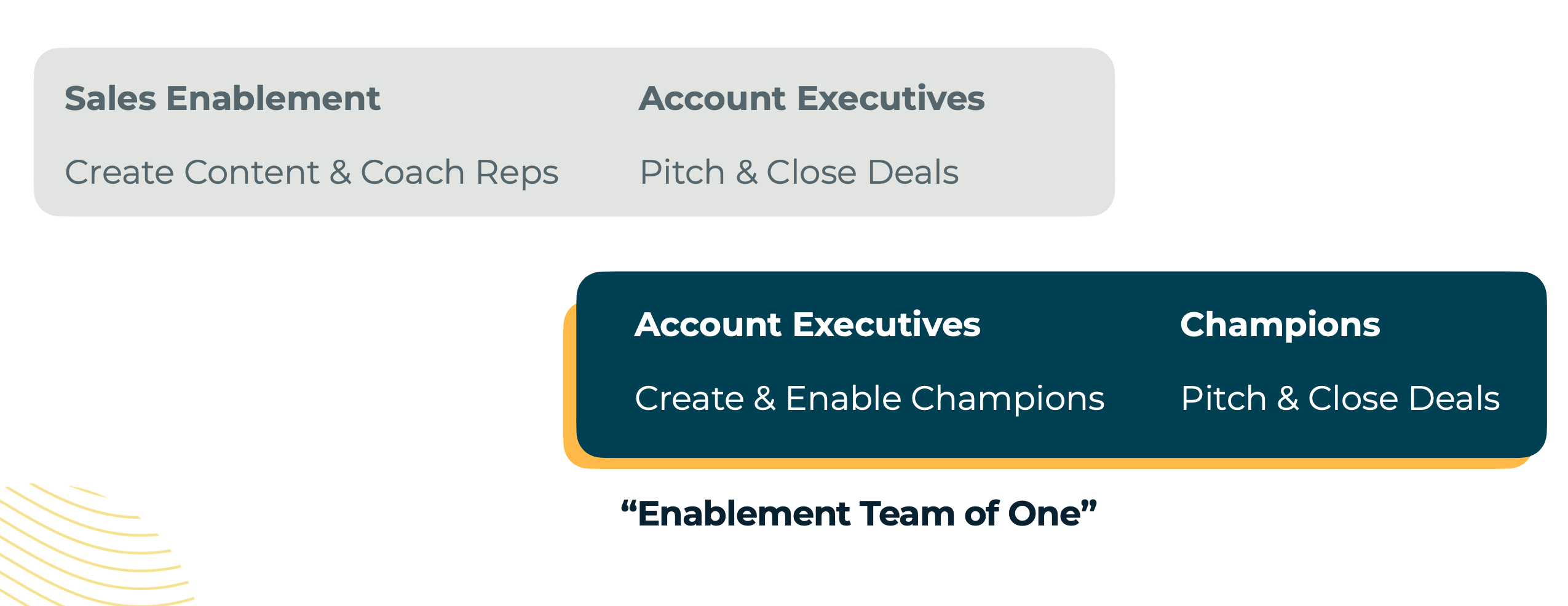
Part 2: The Deal Champion Job Description
The core of a deal champion’s job is to create alignment and accountability within the buying circle.
More sales teams are pushing up market. Leadership is looking to see larger contracts from complex deals. But the biggest difference between selling small business or mid-market, versus the enterprise, isn’t the size of the contract. It’s the number of contacts.
The buying circle expands from two to ten, or more. Champions help you align them all, while keeping everyone accountable. Champions are the glue between three sets of contacts in a deal:
- Direct users. These are the people who interact with your software or services day to day.
- Key stakeholders. These are contacts like management, IT, legal, or procurement you need to clear a deal.
- Decision maker. There can be multiple, but this is essentially the person whose budget is paying the bill, so they’re signing off on the contract.
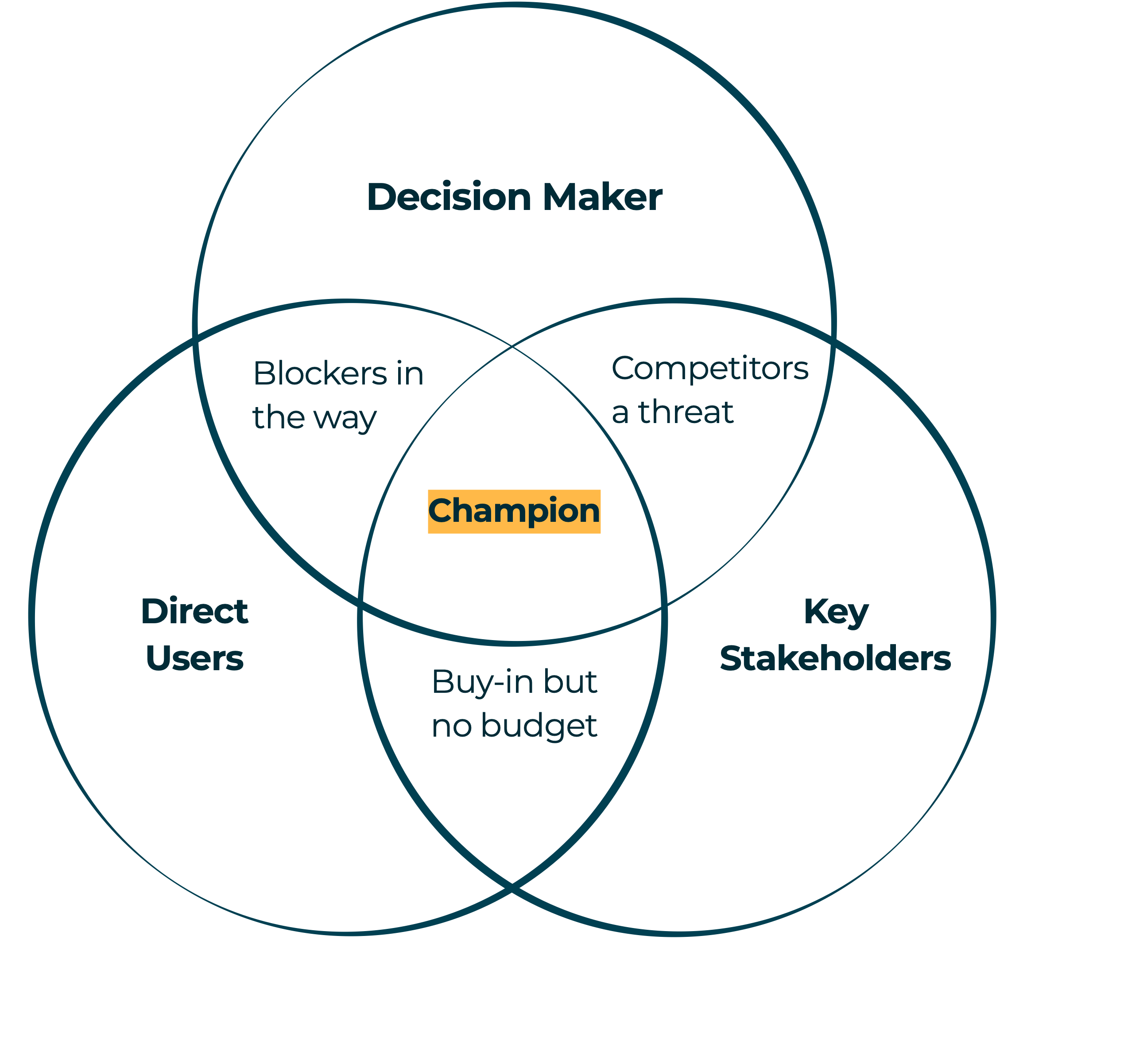
If you only have two of three of these contacts on board, you’ve lost the deal.
For example, you may have direct users and other stakeholders bought-in, but no budget. Or, you've secured budget without any blockers from other stakeholders, but the direct users prefer a competitor. And so on.
A champion can be part of any of these groups, but they’ll always have:
- Incentive. There’s a personal connection or reward that ties them to your deal. There’s something in it for them, motivating them to help get a deal done.
- Influence. They’re in a position to do something about a problem. They know how to leverage titles and relationships to move things forward.
- Information. They can layout a treasure map. They’re able to help you shortcut the path and avoid pitfalls with hard-to-find deal intelligence.
If your contact has influence and information, but no incentive, they’re an Influencer, not a Champion. They’re a Coach if they have incentive and information, but can’t influence others.
You can spot a solid champion by their behavior. They always:
- Challenge the status quo. They're willing to ask hard questions. They push back on how things have "always been done."
- Consider leadership’s goals. They consider why their pain may not be their leadership’s biggest problem, and adjust their message accordingly, so it resonates.
- Commit to owning tasks. They volunteer to move a piece of your deal forward in between meetings — and actually follow through.
Part 3: How to Create a Committed Champion
You’re up to speed on your job, and your champion’s job. Now it’s time to create a champion.
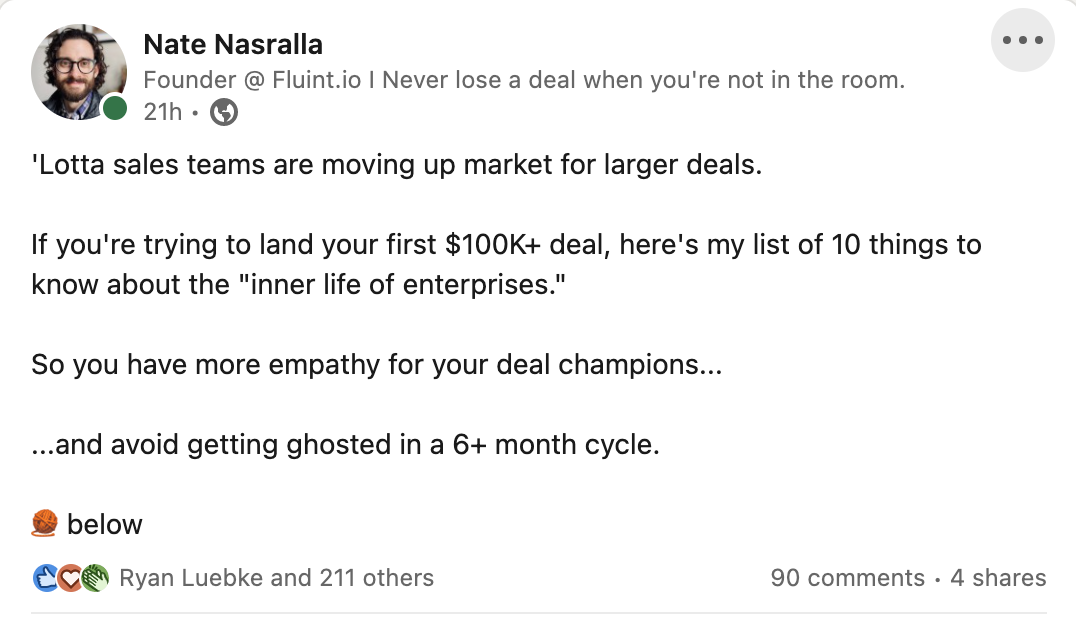
First, if you’re working with the enterprise, or just moving upmarket, it’s easy to feel frustrated by complex sales. Understand, though, there’s always a lot going on behind the scenes.
Read this post with 10 concepts about the ‘Inner Life of Large Enterprises.’ It’ll bring more empathy into your conversations.
Now, notice I’m not saying “find” a champion in the deal. You need to develop them. This starts by asking two separate questions about every deal:
What happens to this contact if they don’t buy my solution?
What happens to this company if they don’t buy my solution?
Each answer will have two components — a problem, and a payoff. Typically, the problem and the payoff are connected, but different for your champion and their company.
Your (Future) Champion’s Problem.
Your future champion has a day job. Time spent with you is time-not-spent on their own goals. Unless, you can clearly align the buying process with the goals that matter to them.
If you skip this piece, they’ll wonder, “What’s in it for me?” That’s when a deal stalls.
Good discovery uncovers what your champion hopes their future will look like (a promotion? more earnings? less stress?), how they’ll measure it, and what’s standing in the way.
Their Company’s Problem.
You have an excited buyer. They can’t wait to share you with their team. But then, the deal fizzles out. Thing is, their biggest problem likely wasn’t their boss's, or their company's.
This is where the nuance comes in. Your sale happens at two different levels:
- First, close your champion (personal problem/payoff).
- Then, help them close the contract (company problem/payoff).
Discovery is the discipline of staying curious to find more depth to these answers throughout the entire sales cycle — it’s not a single stage in your pipeline.
How Curiosity & Discovery Develops Champions
You’re doing discovery correctly when you can describe your buyer’s problem in a way that makes them feel, “Oh my gosh, finally, somebody who gets me.”
The idea is, if you can articulate someone's problem better than anyone else, they'll believe your solution is a better fit than anyone’s, too. To reach this point, you need to dig deep. It’s where the gold is buried. (Cheesy, I know.)
A simple framework you can use for this is The 5 Why’s. The point is to dig below the first problem you hear, and understand the root causes. Five times. Once you’ve found the true cause, you’ll know the right way to frame it.
Finding the Problem
Let’s say you’re in the marketing space and talking with a new prospect. They share:
“Marketing-sourced pipeline was down 30% last year. The sales team is really complaining about it.”
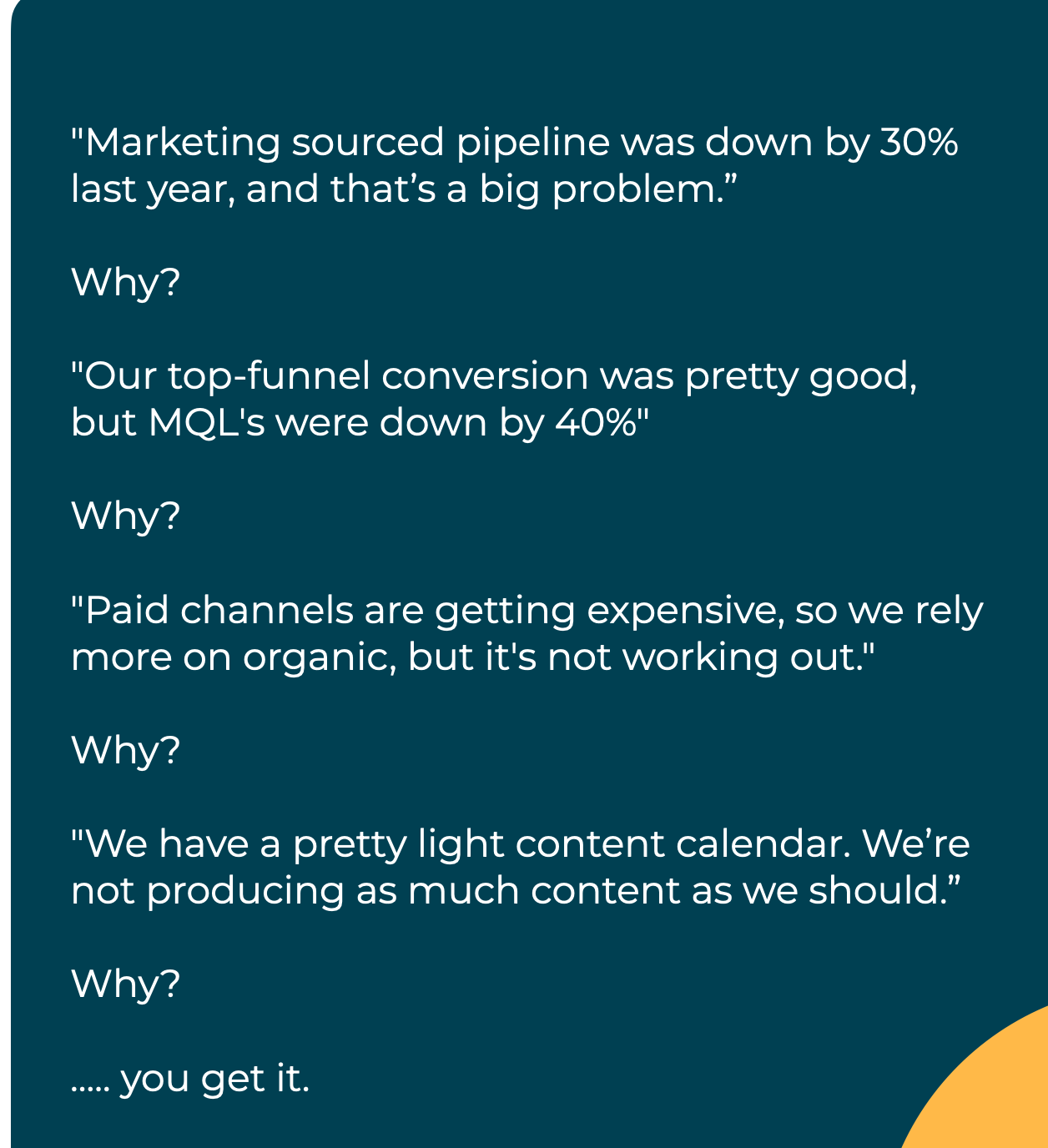
The question is, why? (x5)
As you dig deeper, you find that conversion rates are holding steady, but the mix of leads by source has shifted. Paid channels have dropped off as acquisition costs have climbed, while organic leads stayed steady.
By the way, to go deeper on more discovery tips, the most helpful guides I’ve seen are from Charles Muhlbauer.

Framing the Problem
How you and your buyer frame their problem will define what type of solution is a fit for them. If you get the framing wrong upfront, you’ll run into issues downstream.
For example, if a buyer believes the crux of their problem is mismanaged ad spend, causing low return on their campaigns, they’ll be interested in a totally different type of solution.

The more you can help your prospect clarify and correctly frame their problem, the better positioned you’ll be when aligning your solution.
Craft a Compelling Problem Statement
This statement is how you convert a prospect who fits the champion profile, into a true champion.
Remember from earlier, people do business with the partner who can articulate their problem better than anyone. (Plus, you’ll be getting a head start on point one to your business case.)
First, let's look at the formula. Then, we’ll break down each part.
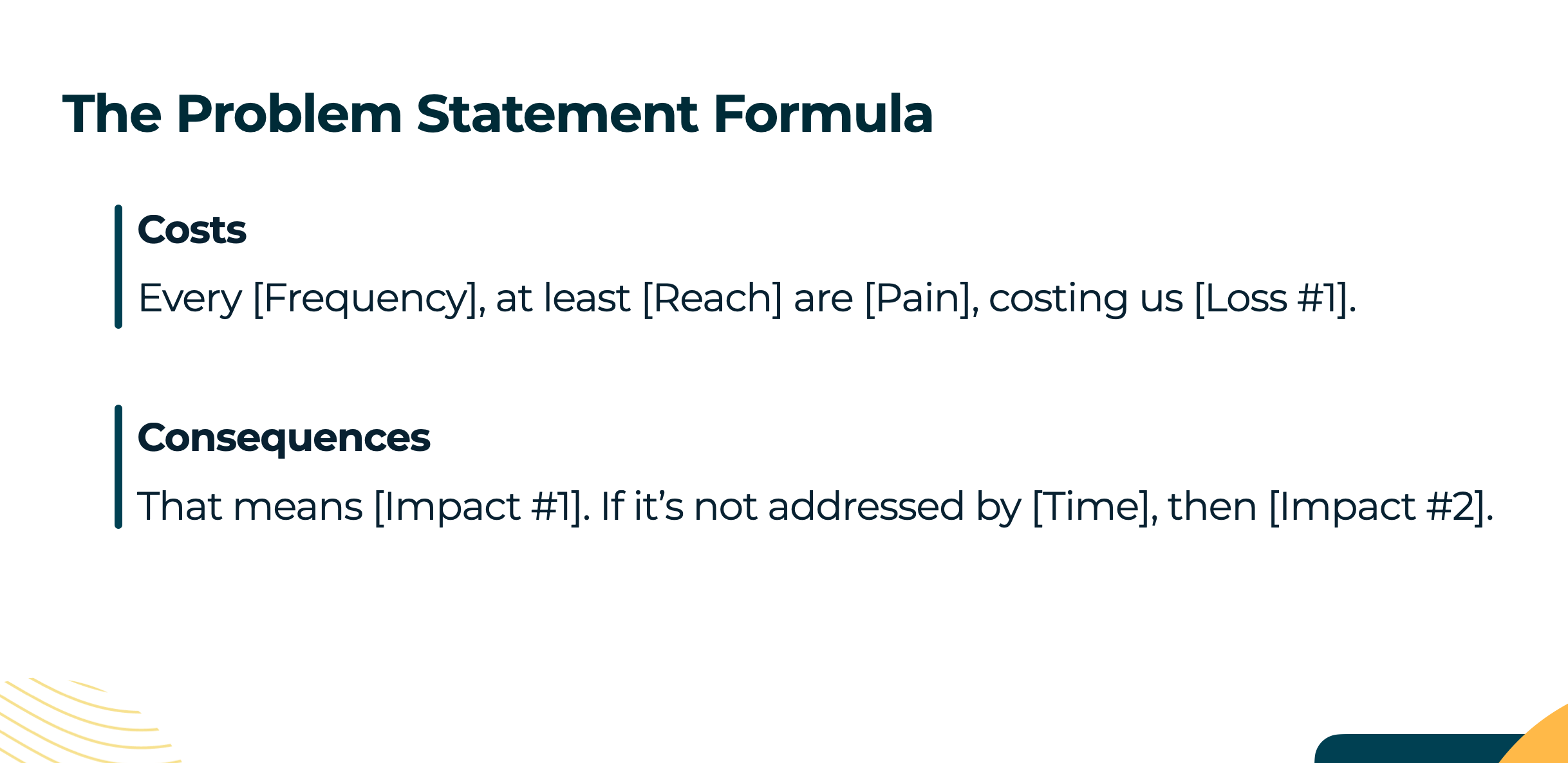
Part 1: Costs
Research around the idea of “Loss Aversion” is debated. But there’s one thing we can say for certain. We act faster to stop someone who stole our debit card (active pain) than we act to rebalance a retirement account (future gain).
Which framing sounds more powerful in this chart?
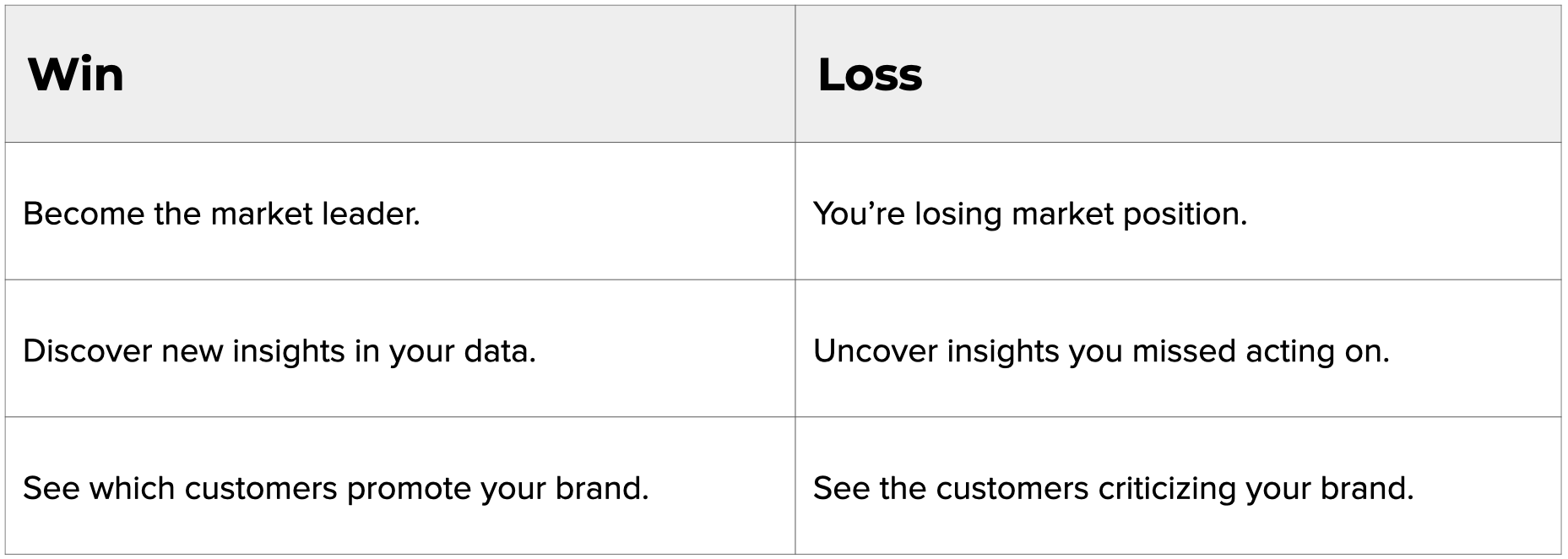
To make the loss compelling, be specific. And to be specific, quantify the loss your buyer’s problems are creating whenever possible. A simple way to quantify loss is:

Don’t give it your best guess. Ask your buyer what their data says it is. Then, write it down with them.
Here are a few examples, with some made up numbers:
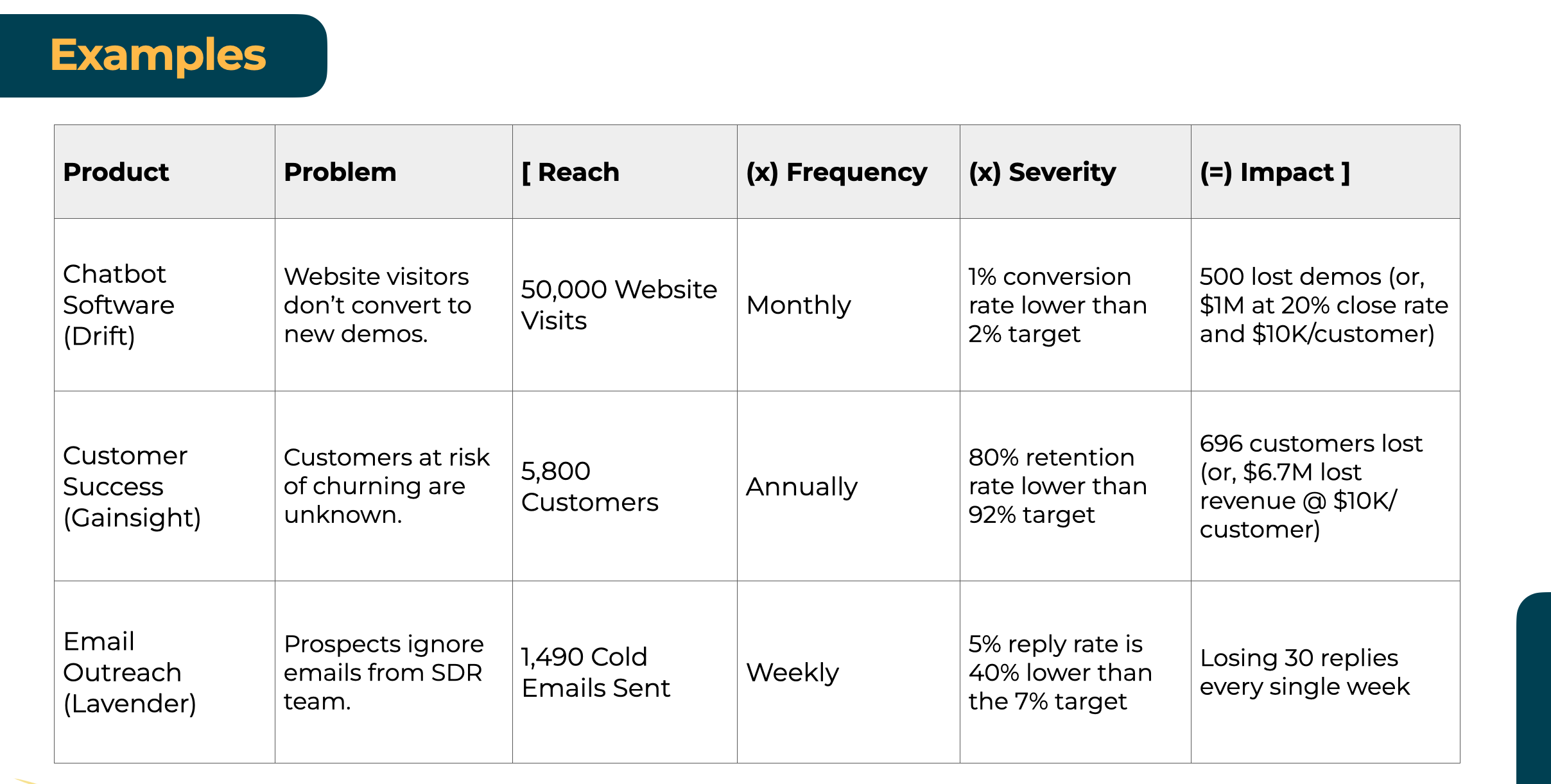
Now, once you’ve quantified the problem, don’t assume the loss is meaningful. If you’re selling to the enterprise, beware of The Law of Large Numbers.
Pointing out a $1M loss is pointing out 0.00001% in a business that does $10B in annual revenue. Instead, ask questions like:
- How does this estimate of [X] compare to what you expected to see?
- How do you think [decision maker] would react to seeing this number?
- Are there other problems your team’s facing that are more pressing than this?
Part 2: Highlight Consequences
You’d be surprised what overwhelm and burnout can force us to live with. We grow numb to our problems, and apathy becomes an acceptable solution. But often, that’s because we can’t see the full consequences of inaction. Once you’ve quantified the loss, press into its implications.
There are three levels of consequences you’ll want to speak to:
- Functional Problems: “It takes a long time to build customer surveys and analyze the data.”
- Strategic Problems: “We’re not sure which customers are a churn risk before their renewal date.”
- Personal Problems: “Me, or someone on my team, may lose our job if renewal revenue declines.”
Now, nobody likes talking consequences. So generally, it’s best to lead your buyers to them with questions — not statements. Questions that start by asking:
- What happens if...
- What does this mean for...
- How will that affect...
Let's use the Drift example from above. We'd translate those costs into consequences by saying something like this.
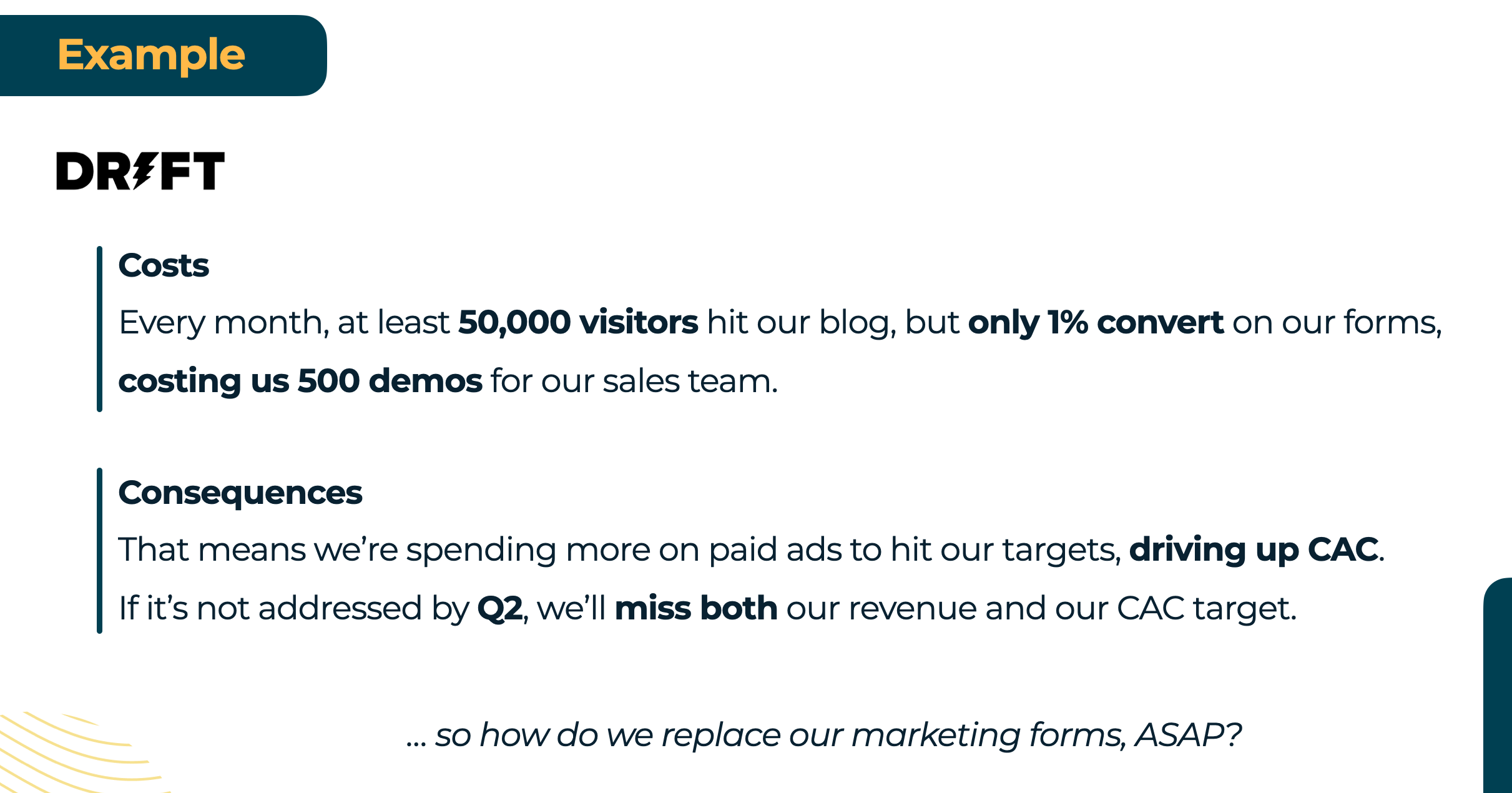
You could go even deeper on this. Remember the difference between a champion’s and a company’s problems? Make sure their problem statement captures both levels.
- For a contact like the CMO, the consequence of rising CAC (cost to acquire a customer) may be a lost bonus.
- For the company, it might be lost investment from venture funds who find the CAC unattractive.
Bringing a Problem Statement Together
If your head is spinning with “math” right now, your buyer’s will be too. While you’ll quickly become fluent in problem statements using this framework, your buyer will need help. Make sure to:
- Put their story to the test. After you’ve drawn out all the component parts with your champion, play it back to them. Is it compelling?
- Develop a problem statement process. Getting the data you need to turn a minor-annoyance into a can’t-ignore mega issue may require some creativity. There’s a case study on that, below.
- Check out the case study. Here’s how I’ve put this to work to close a breakthrough deal.
Establish Problem-Product Fit
Congrats. If you’ve done all of the above, you’ve gone deeper on the problem than 90% of sellers. And, you’ve laid the foundation for a compelling, internal narrative.
Before you get deep into your solution, it’s time to talk about the approach.
To continue with the Drift example, integrations and workflow automations shouldn’t be part of a conversation until your champion agrees, “Starting conversations, instead of using marketing forms, is the better approach for us.”
The question to ask here is:
”What would have to be true of a solution for it to work in your case?”
This lets you gauge the level of structure your prospect has (not) put in place in their buying process.

If you hear shallow and informal answers, it’s an opportunity to add value. You've sold your product many times. You’ve seen how different people evaluate a purchase. But your buyers may be walking through a decision like this for the very first time — especially in an outbound sales environment.
Blend the emotion of a problem carrying personal implications, with the logic of a structured and low-regret decision framework:
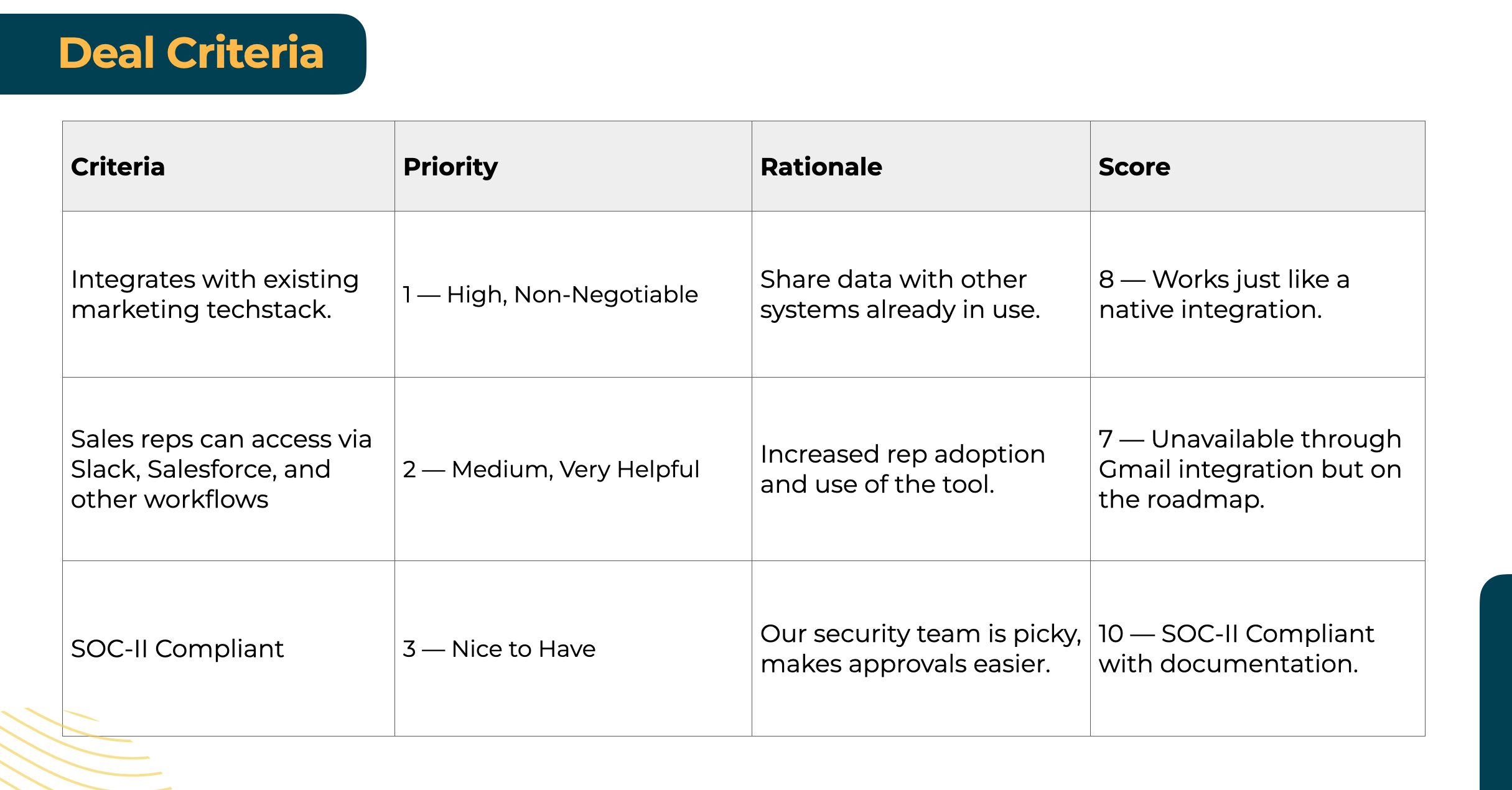
If you’d like to copy and share this with your buyers, here’s a simple version built in Google Sheets:
If you have competitors, add them into your template. This can be counterintuitive, because most sellers try to keep the competition away from a conversation.
But your competition exists, whether you talk about them or not. Introducing them creates trust. Belal Batrawy says this beautifully.
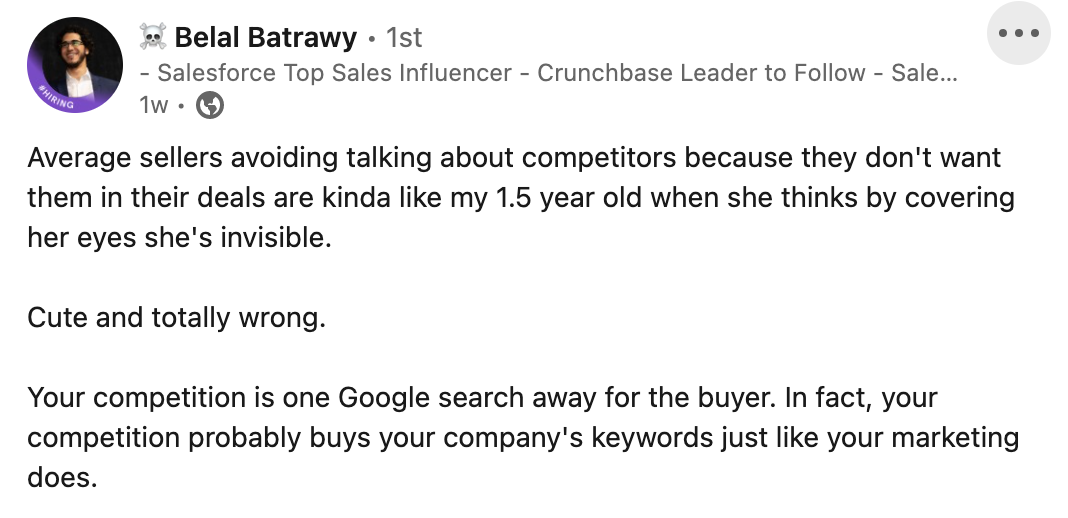
How to Test & Close Your Champion
A committed champion can help you overcome almost any obstacle. But how do you know if you have a committed champion on your side? First, confirm that you have, in fact, “closed” your champion.
You’ve done this when your champion confirms that if it were up to them, they’d sign a contract.
Questions that can confirm this and test your problem-product fit include:
"How confident do you feel {{product}} can help you address {{pain}} on a scale of 1 - 10?"
"...is there something you feel you'd need to see, but haven’t, to feel a 10/10 confident?”
“Let’s say for a moment that budget and legal questions are all squared away — would we be your partner of choice? Or is there anyone else you’re still looking into?”

Five Ways to Test Deal Champions
To be certain you have a partner in your champion, put them to the test (shoutout to Ayan Dutta here).
The fun thing about each of these tests is, when done well, it adds to your relationship. It creates a new and higher level of commitment, in a self-reinforcing test/build loop.
Each of the fives tests are meant to bring out the behaviors of a strong champion.

Note, the key to an effective test is ensuring it’s value-added. For example, if you’d like to flip roles with them, to hear how your champion would pitch your product to their team, say:
“I’d love to make sure I capture what matters most to you in my recap. Would you be up to share how you’d pitch this to your team in a meeting so I can hear?”
One more word of caution. As you move into more intimate communication channels — like texting — you’re expanding from a purely professional, into a personal zone. Handle this level of trust with care.
Now, here’s an example of a champion I worked with who passed with flying colors.

She took the problem statement we built and sent it around her team, to see if they shared her view.
Then, she forwarded me that email thread with a progress update.
The Three “T’s” of Multithreading with Champions
If you get a strong signal from these tests, and you created a solid champion, you’ve hit a tipping point. Your conversations should shift from, “Why work together?” —> “How do we work together?”
The strongest signal, however, is a champion proactively “multi-threading” their team.
The reason is there’s trust, transparency, and teamwork at play. Your champion is confident you’ll add value, they have nothing to hide from you, and they believe they’re better off with than without you.
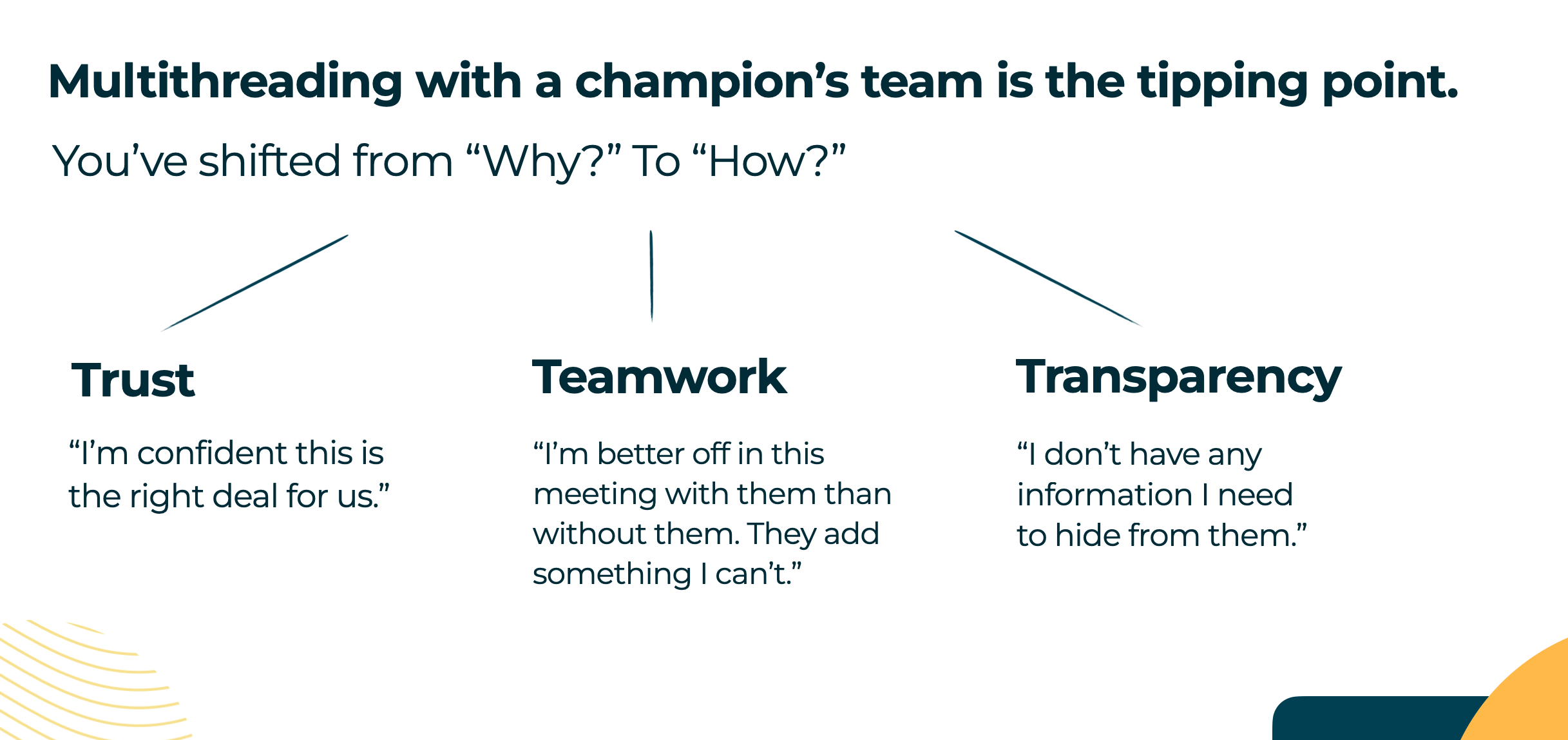
Part 4: Creative Ways to Keep Champions Engaged
We just covered a list of ways to test champions. As if to say, “Prove it.” There is, however, a key point when transitioning into the second half your job — moving from creating, to enabling, a champion.
You must avoid sending a “just checking in” email. At all costs.
The reason? Keeping deals alive is your job. Not your champion’s.
Assuming you've already qualified the deal — and it's a legit opportunity — a champion’s lack of engagement isn't for a lack of reminders, or them forgetting to reply.
More often, it's a signal that you’ve not given them a strong enough reason to re-engage. There’s not enough value from you, or the buying experience you’re facilitating, to engage. Instead, your value is 100% dependent on buying your product.
Here’s what to do instead. A list of forward-worthy follow-up ideas, first shared with the Sales Hacker community, plus a framework for worldclass follow-up to keep your champions engaged.
Craft a Future Press Release.
Create a vision that energizes your champion's entire buying team. Make the headline all about a breakthrough you'll enable, and format it like the press releases you see on the Media section of their website.
This works. But only if you think as big as an executive.
For example, if I were selling marketing software that helps with SEO content, I'd skip the talking points about “keyword analysis,” and appeal to the CMO’s ambition. Something like:
“$110M Series C Backed by Sequoia, Driven By Efficient Organic Growth”
You see, organic traffic means lower acquisition costs, which big-name VC's love.
Ghostwrite a Congrats Email From Their CEO
This is similar, but focused on helping your champion taste a personal win. If you've seen stories of your users getting promoted as a result of their work, try ghostwriting an all-staff email from their CEO.
Match their email signature, and focus the narrative on something you can help enable.
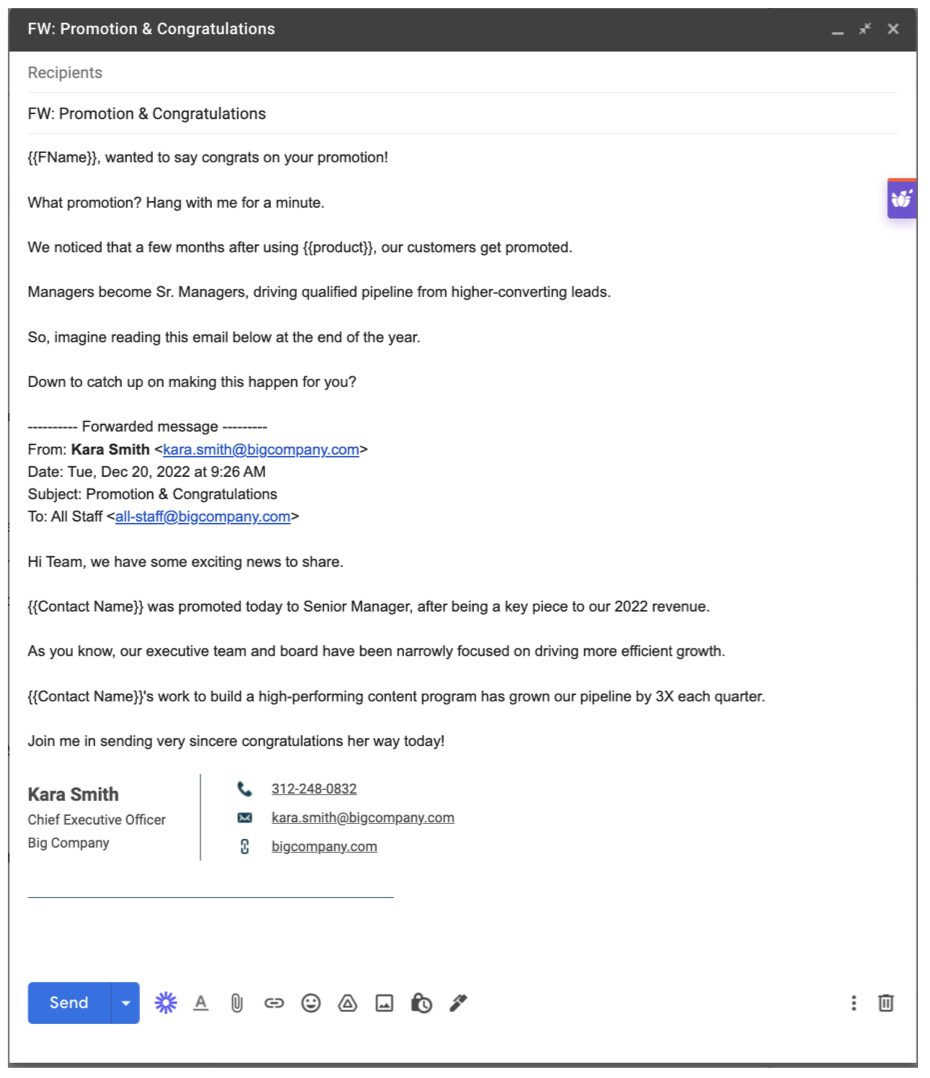
This is a good stat to track, too. How many of your buyers get promoted after working with you?
Write Up an ‘Idea’ Email With a Truly Helpful Resource
The mantra here is, "Help me get my job done today. Tomorrow, I might pick up our product conversation."
Consider a tool, resource, or material you can share with your prospects. Then, align this with a to-do you know they'll have on their list for the week. Shoutout to Will Allred for his collab here.
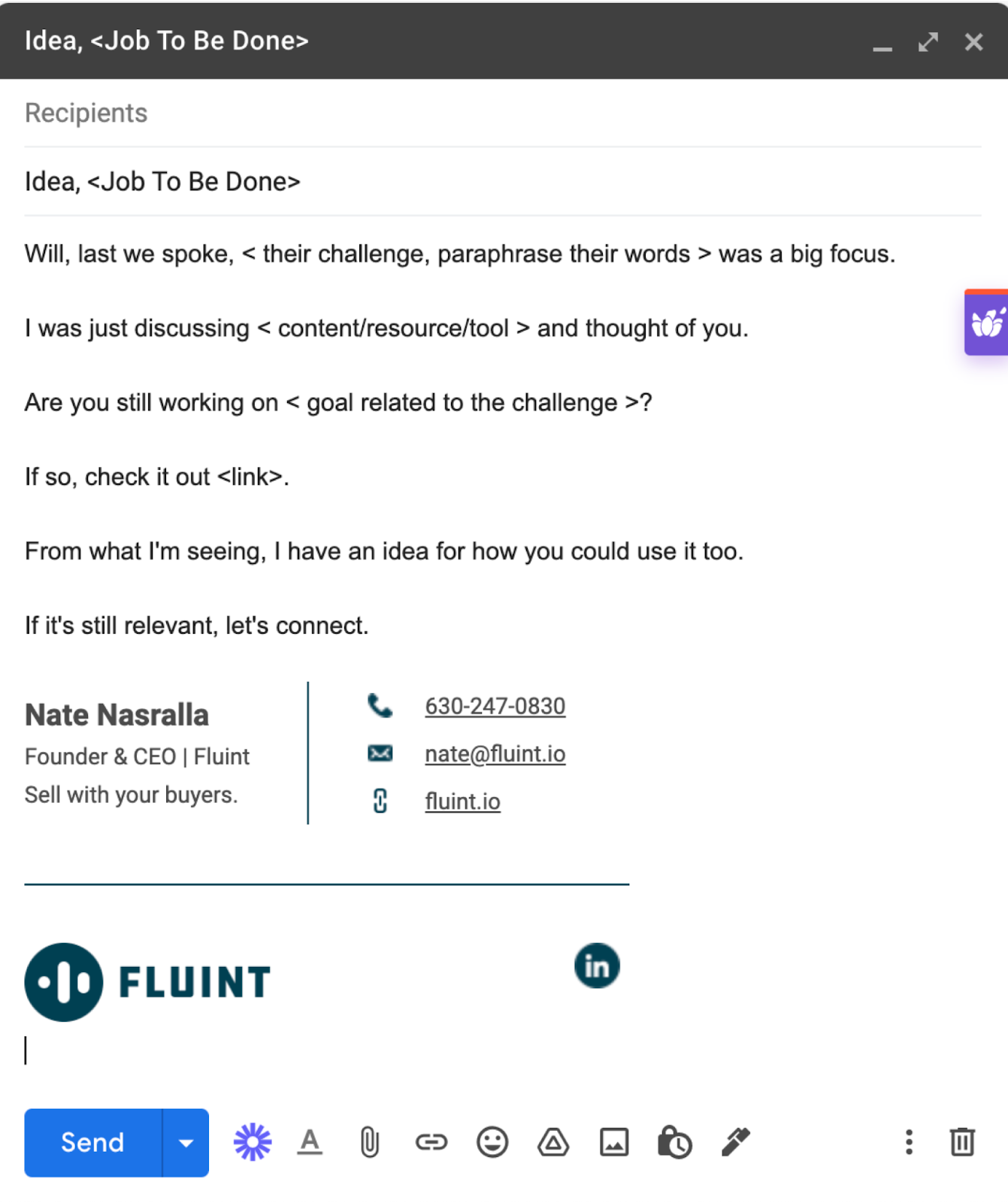
When I sold fundraising software, I'd make a $10 donation and forward the gift receipt, while attaching a checklist of ways to improve their giving experience. It helped them, without requiring them to buy our product.
Schedule a Guest Interview on Your Blog
Everyone loves a chance to showoff what they know. If you’re working with a key or senior employee, feature them in a piece of content from your marketing team.
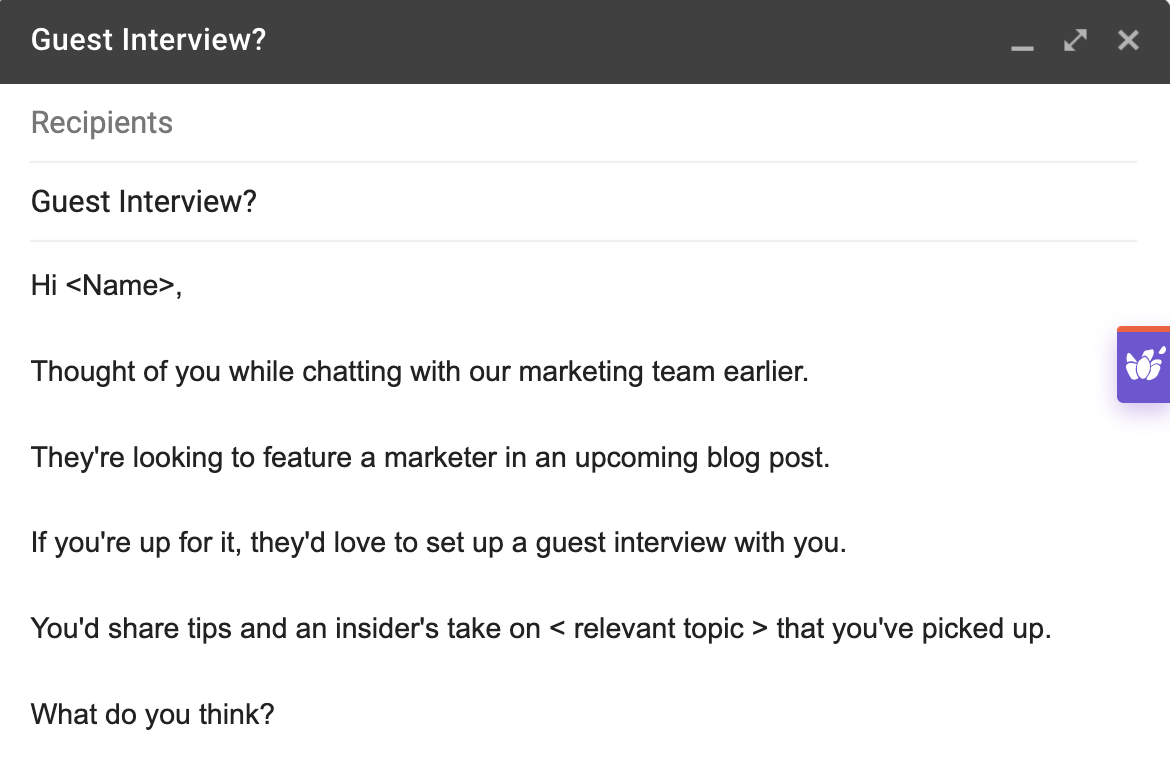
Check with marketing first. But chances are they’d love a real-life expert contributing to their content.
Do What You’re Not “Allowed” To
When you go to bat for your buyers, they’re likely to show up for you. Create an exclusive offer for select buyers, then have your manager approve it as an offer to keep in your pocket.
This should be something you’re not "technically" allowed to do, and could never do for everyone. But for the right deal, you can get away with it. Think opening a sandbox account, running a sample report, anything that helps your buyer de-risk their decision.
Send a Present You Can't Send Anyone Else
What makes your prospect “them”? On a human level? Discover that, then send a gift that screams, “I see you."

Here's an example. One of my prospects loved Chinese takeout, so I found a ‘Make Your Own Fortune Cookies Kit.’ Anyone else would have found that super weird, but they loved it.
Now, you’ll notice that none of these ideas are "easy hacks."
Creating surprise and delight requires time and thoughtfulness. But it's worth it, without a doubt. You'll bring an extra shot of energy to your champion's week, see stalled deals come back to life, and you’ll boost your close rate.
All without sending an email that says “just checking in?”
Part 5: Enabling Your Champion’s Internal Sale
Your pipeline’s ‘Closed Lost’ column is filled with prospects who have the exact same problems as your customers. Even deals who had a committed champion.
So what gives? How does a picture-perfect deal with inside help fall through?
Nobody cared (enough).
Sometimes, a competitor swoops in. Other times, a budget gets re-allocated. But more often, your deal just slipped down the priority list. Your champion couldn’t get their team interested.
That’s because your champion’s message didn’t cut through the clutter.
Some champions are natural storytellers. They hit all the high notes. They know how to make their team lean in. But others need your help, so this doesn’t happen:

The answer? It starts with our original two takeaways.
Enabling your champion with a clear message, and the materials they need to communicate it.
Four Elements of a Bulletproof Business Case
If you followed the playbook up until this point, you’ve already collected the inputs you need to build a business case with your champion. There are four elements and two principles summarized here:

One note on the payoff. Earlier, we talked through the two questions you need to answer about every deal. Now, the question is what will happen after your product is implemented?
Most importantly, what’s the payoff that your champion’s boss or board wants to see?
Camouflage Your Materials as an Internal Document
Even if you’re multithreaded, buyers have internal meetings about you, without you.
Since you can’t be in every meeting, influencing your message when you’re not around is key.
Rather than kicking over a stack of case studies and marketing materials, camouflage your sales message inside your buyer’s internal format.
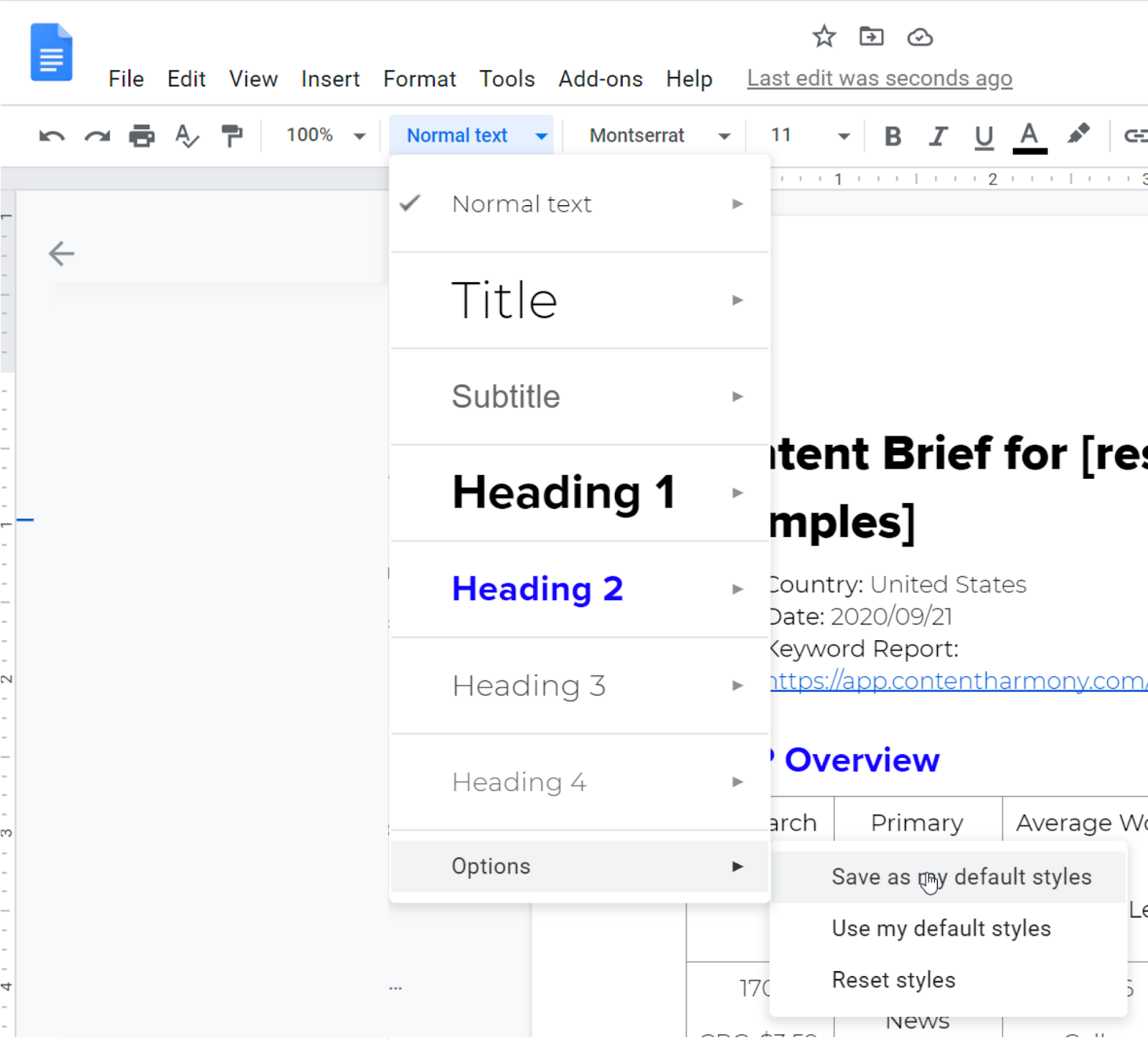
Buyers love it. It saves them time, and it looks familiar. Most teams have a standard deck or document. Some use Google Docs. Others, PowerPoint. To maximize the chance your message gets through, ask for a copy.
Then, translate your business case — a problem statement, its cost, your approach, the payoff, etc. — into their format. From there, it’s great to link out to your own files like:
- Meeting recordings
- Product walkthroughs
- Case studies & customers references
- Legal, security, compliance documentation
Anyone who’s digging into these supporting links are either, (1) interested because the overall message resonated first, (2) is a stakeholder and not the ultimate decision maker, who’s willing to dive into the details. Which means, you should keep the core of this business case to two pages, at the maximum.
This might feel like an extra step to you, but it’s key.
We interviewed 290 B2B buyers, who explained how they sift through stacks of follow-up links, listen to call recordings, hunting for the two sentences in each document or clip that are relevant. Then, they:
- Wing their internal pitch without anything guiding them.
- “Frankenstein” their own materials by patching together snippets of decks, downloads, demos.
Buyers pick option #1 because they won’t send your sales templates and marketing material to their boss. It doesn’t sound like them, or speak to their boss’ exact goals.
Remember tip #4 from our list of ten enterprise concepts?
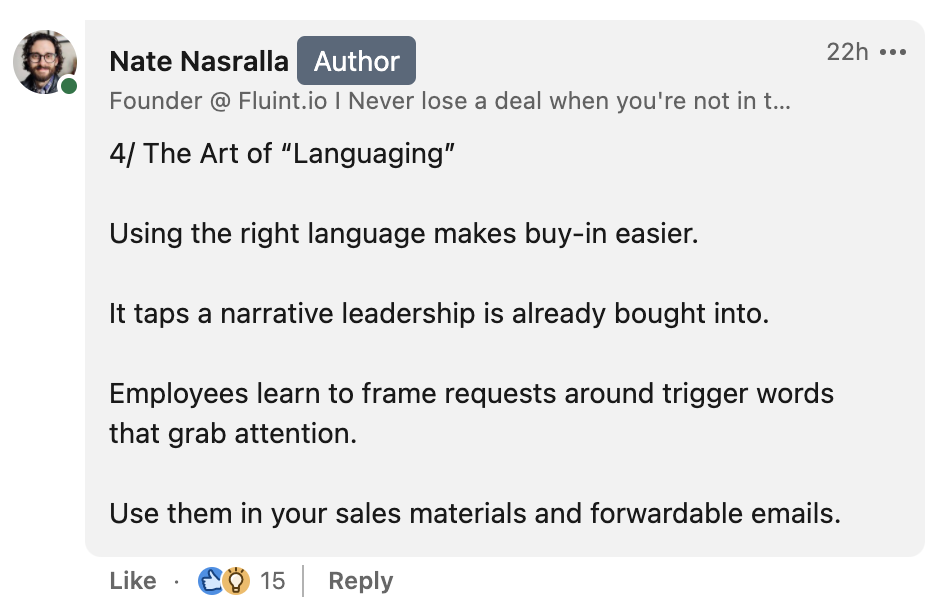
Language is important.
Experienced buyers typically pick option #2. They'll invest their own time into your sale, by crafting their own "enablement materials." Which, of course, gives them all the control over your message.
The alternative is crafting their message and materials together.
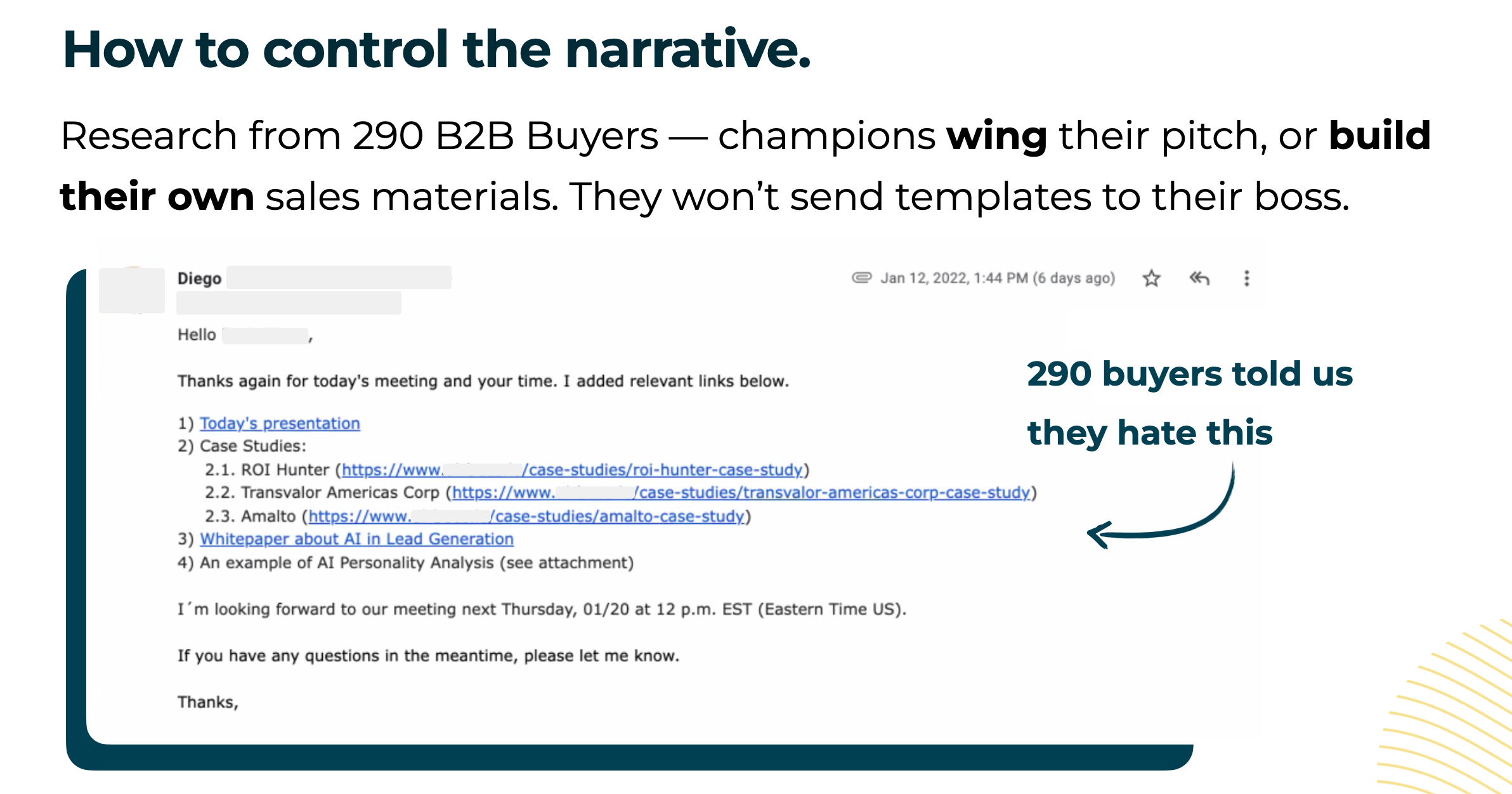
Four Messaging Frameworks Champions Love
The frameworks linked here are the result of these 200+ conversations with B2B buyers.
The internal messages they used to engage their team boiled down to one of these four structures.
As you dive in, keep in mind:
- Use your champion’s words. Not your marketing team’s.
This is how you make your material “pop.” Don’t fall back on content for the average buyer. Instead, focus on each buyer’s exact words. Show them you know them and believe they’re unique.
- Write it out, with them.
Putting your buyer's words down on paper (or a screen) forces them, in a loving way, to form a point of view. Written words create an extra degree of commitment and clarity. Conversations alone are less “permanent.”
Before we carry on, you’ll want to conduct a ‘pre-mortem’ with your champion. Try asking questions that identify objections they may face. Objections that would cause a deal to die.
“If your team sent you an email saying they’re skeptical, what would be the reason?
“Let’s say you’re regretting our partnership after the first 30 days. What went wrong?”
Then, ensure your champion’s feedback is captured in the material. Coach them on handling those objections. Are there responses you’ve seen most effective with other buyers? Share them.
It’s likely your champion will face objections without you around, so you want them to be prepared.
How to Write a Compelling, 'Forwardable' Email
Next, you need to get your business case in front of the decider — like an executive, or an SVP — to collect their feedback. You want them to share critical input with you, and your champion, during a meeting.
Remember, one email from a high-ranking title that favors (or fights) your deal can make all the difference. So you need to ensure your message is read and resonates at the highest level. To get this done, make it unbelievably easy for your champion to share your business case.
This is where writing a 'forwardable' email comes in.
Let's continue with our example of selling an SEO content tool, and working with a champion, Morgan the Marketing Manager. Here's how I might write an email to grab her CMO's attention, in just 100 words.
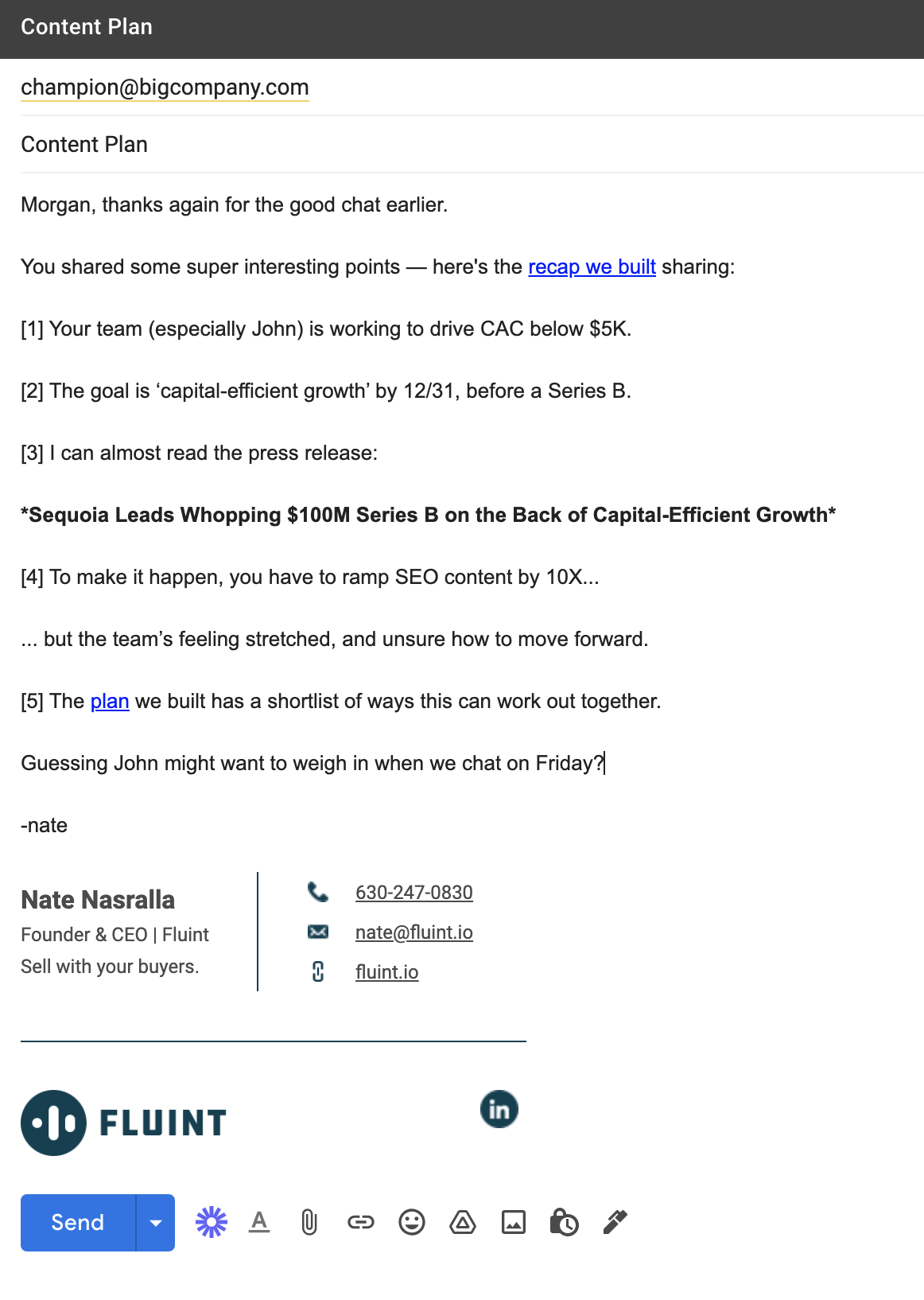
Here are the principles behind this example, which weave together a number of the points in the playbook:
Subject: Reads like an internal to-do or request.
Hi < Name >,
[1] Open with a big, strategic objective that affects the company.
[2] Insert a trigger phrase that’s familiar to your champion's leadership.
[3] Use visual language to stir up emotion about a bright future.
[4] Build tension. Show a challenge that makes that future uncertain.
[5] Align your ask with feedback on your plan.
- Rep’s Name
The idea behind this message is that facts may communicate information, but feelings create influence.
Your email should create both excitement and tension about a topic that the decider cares deeply about. Paint a compelling picture, while pointing out there's a strong possibility that reality is never reached.
When there’s a real threat to the bright future an executive is envisioning — and there's a plan that was created to do something about it — they’re more likely to step into your deal personally.
Use a Mutual Action Plan (MAP) Like an Executive
MAPs are a hot topic. More teams are introducing them into their closing process, and buying software to manage them. Many teams still use them incorrectly, however, as they quickly become an excuse for “reminders.”
Done well, MAPs become a strategic tool that align you on major points like roles, ROI, and outcomes. For this to be the case, though, the business case (see above) has to have been built out and fully-developed.
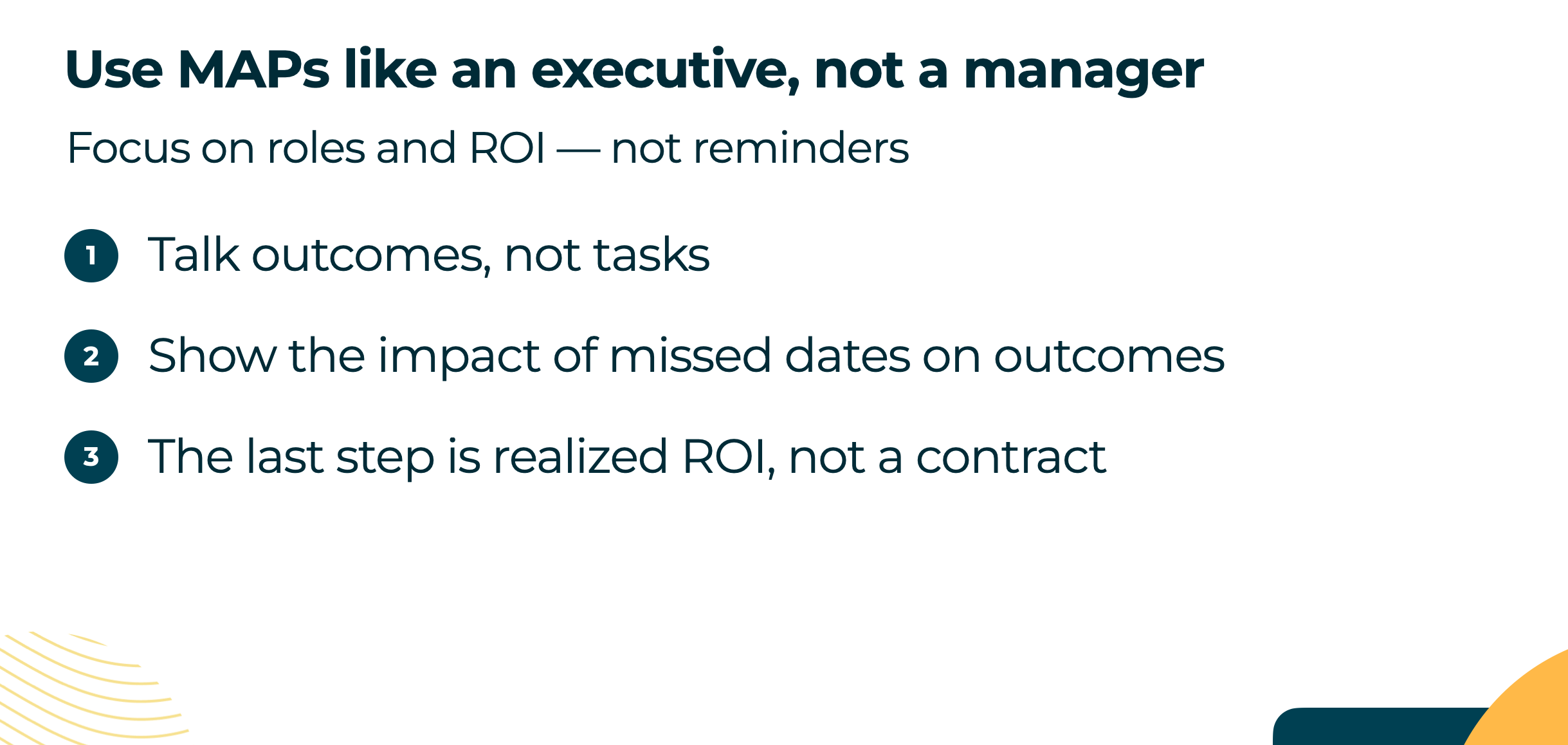
If you’re looking for a template to get started with, dig into this one:
Using a “No” to Enable Champions
By this point, you’re in the final stages of closing your deal. And you’ve likely noticed that the overall tone of this playbook is empathy and enablement.
There are times, however, when the best thing you can do for a champion is give them a “no.”
In this example, a buyer from a marketing team was looking for me to guarantee a certain level of performance in their campaigns — which I believed was unreasonable.

Eventually, I discovered he was under extreme pressure from his CMO. She had set incredibly aggressive goals for the team. But nobody had pushed back on them. This email was a turning point. Not only for our deal (which we closed 20 days later). But for my champion’s job.
In sum, a firm “no” may just be what your champion needs most.

If you’ve found any part of this playbook useful, I’d be extremely grateful if you’d be willing to:
- Share on LinkedIn.
Help us reach our goal of 1,000 Account Executives using this playbook. Share, and connect with me.
- Follow Fluint.
We’re creating and sharing content on how to create and enable champions every week. Signup below.
Thanks again for reading. It means the world to our team 🙏🏼

Oh hey! If you made it this far... you might want to test drive Fluint
Fluint lets you apply everything in this playbook to the deals you’re working on, right now. Get an executive-ready content in seconds, built with your buyers words and our AI.
